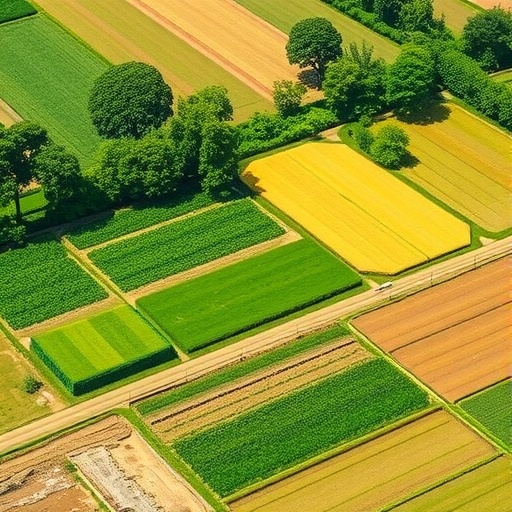
A groundbreaking new study led by researchers at University College London (UCL) dissects the long-standing debate surrounding agricultural expansion and intensification, revealing that the ecological impact on biodiversity is far more intricate than previously believed. Contrary to the prevailing assumption that intensifying production on existing farmland is uniformly less harmful than converting natural habitats into agricultural land, the study uncovers a nuanced picture where the relative impact of each approach varies dramatically depending on multiple ecological and geographical factors.
The research team meticulously evaluated biodiversity consequences associated with intensification and expansion across the globe, focusing on four critical staple crops: maize, soybean, wheat, and rice. Together, these crops contribute to over half of the world’s calorie supply, underpinning global food security. By integrating an extensive biodiversity database with spatial data on natural vegetation and agricultural yields, the team conducted an unprecedented comparative assessment within already established farming landscapes, deliberately excluding pristine natural environments to isolate the effects of intensification and expansion on modified lands.
Central to the study’s methodology was measuring key biodiversity indicators such as species richness—the diversity of species present in an area—alongside total species abundance and their spatial distribution patterns. The researchers analyzed these metrics both within cropland areas and the surrounding natural habitats, providing a comprehensive view of how different agricultural practices ripple through local ecosystems. This multifaceted approach allowed the team to parse out subtle variations in biodiversity responses that traditional evaluations often overlook.
Their findings challenge simplistic narratives about sustainable agriculture. While it might seem intuitive that intensifying farming reduces harmful expansion into natural ecosystems, the results demonstrate that intensification can, in several cases, exert a more severe toll on biodiversity than the physical spread of farmland. This is largely due to the intensified use of inputs such as fertilizers and pesticides, which disrupt ecological balances and degrade habitat quality in ways expansion alone does not.
However, the research underscores that neither strategy—expansion or intensification—is categorically superior or worse. Instead, the impact depends heavily on specific regional contexts, crop types, the extent and quality of adjacent natural vegetation, and which biodiversity parameters are prioritized. For example, intensifying maize production in a relatively fragmented landscape may yield drastically different outcomes compared to expanding soybean farming in a region with intact natural corridors.
This complexity runs counter to prevailing agricultural policies that frequently favor intensification under the assumption it spares natural lands. According to Dr. Silvia Ceaușu, lead author from the UCL Centre for Biodiversity & Environment Research, “Our study reveals that the ecological costs of closing yield gaps via intensification may be significantly underestimated. This calls for a more nuanced approach that recognizes the variable trade-offs involved.”
The implications of the study extend into international trade and environmental policy realms, where certification schemes and deforestation curbing initiatives often restrict crop sourcing to existing farmland. Such blanket policies risk oversimplifying the science and may inadvertently favor intensification practices that, under certain conditions, could inflict greater ecological harm.
Beyond policy, the researchers advocate for more sustainable forms of intensification where it is employed. Techniques such as biological pest control, conservation of natural vegetation patches within agricultural mosaics, and integrated land management may help mitigate biodiversity losses. For consumers, the tangled nature of sustainability signals a need to reduce food waste and limit consumption of resource-intensive products like meat, both recognized drivers of agricultural expansion and intensification pressures.
Professor Tim Newbold, co-author and biodiversity expert at UCL, elaborates on the study’s broader message: “There is no one-size-fits-all solution for increasing agricultural yield sustainably. The balance between expansion and intensification—and their impacts on biodiversity—is contingent on a mosaic of environmental and socioeconomic variables that must be carefully considered.”
Recognizing the study’s limitations, the team emphasizes that their analysis applies exclusively to existing agricultural landscapes and does not endorse converting untouched natural habitats into farmland, which remain critical reservoirs of biodiversity and ecosystem services essential for planetary health. Instead, the findings promote strategies rooted in local data and a holistic understanding of environmental impacts to guide sustainable agriculture planning.
David Leclère, co-author affiliated with the International Institute for Applied Systems Analysis, highlights the path forward: “Achieving food security while conserving biodiversity demands reevaluating how we balance intensification and expansion. Informed decision-making that accounts for crop-specific conditions and regional ecological contexts is vital.”
This comprehensive research, published in the prestigious journal Nature Ecology & Evolution, was supported by the UK Global Challenges Research Fund Trade, Development and Environment Hub. It presents a compelling call for rethinking agricultural paradigms amid mounting global food and environmental challenges, urging scientists, policymakers, farmers, and consumers to embrace a more complex, nuanced perspective on how best to harmonize human productivity with biodiversity conservation.
Subject of Research: Biodiversity impacts of cropland intensification versus expansion in existing agricultural landscapes.
Article Title: Geography and availability of natural habitat determine whether cropland intensification or expansion is more detrimental to biodiversity
News Publication Date: 1-May-2025
Web References:
https://doi.org/10.1038/s41559-025-02691-x
Keywords: Biodiversity conservation, Biodiversity loss, Agricultural intensification, Sustainable agriculture, Land use policy, Cropland, Land management, Environmental policy
Tags: agricultural expansion vs intensificationbiodiversity indicators in agriculturecomparative assessment of farming methodscrop production and environmental impactecological and geographical factors in agricultureecological effects of farming practicesfarmland intensification impact on biodiversityglobal food security and biodiversityspecies richness in farming landscapesstaple crops and biodiversitysustainable agriculture practices and biodiversityUniversity College London agricultural study





